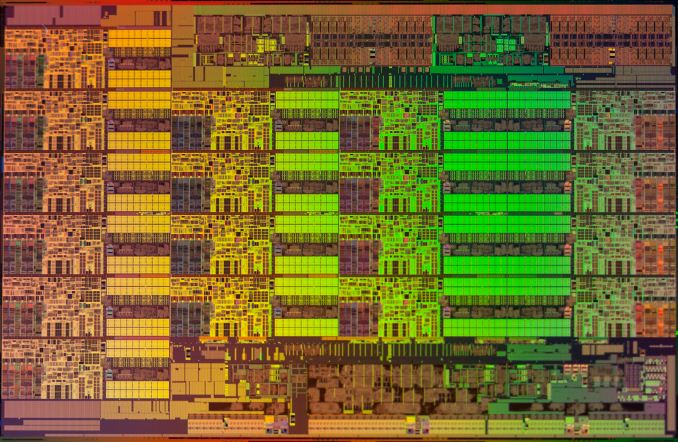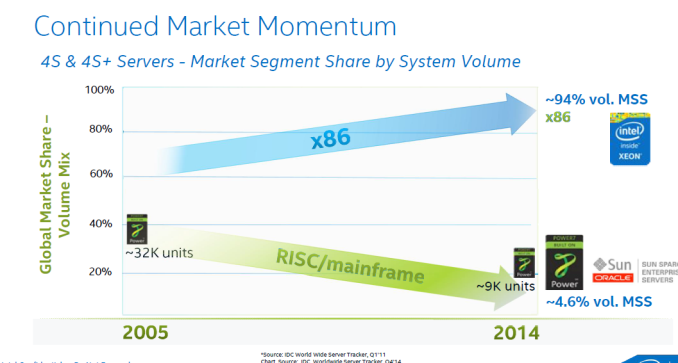The Intel Xeon E7-8800 v3 Review: The POWER8 Killer?
by Johan De Gelas on May 8, 2015 8:00 AM EST- Posted in
- CPUs
- IT Computing
- Intel
- Xeon
- Haswell
- Enterprise
- server
- Enterprise CPUs
- POWER
- POWER8

The story behind the high-end Xeon E7 has been an uninterrupted triumphal march for the past 5 years: Intel's most expensive Xeon beats Oracle servers - which cost a magnitude more - silly, and offers much better performance per watt/dollar than the massive IBM POWER servers. Each time a new generation of quad/octal socket Xeons is born, Intel increases the core count, RAS features, and performance per core while charging more for the top SKUs. Each time that price increases is justified, as the total cost of a similar RISC server is a factor more than an Xeon E7 server. From the Intel side, this new generation based upon the Haswell core is no different: more cores (18 vs 15), better RAS, slightly more performance per core and ... higher prices.
However, before you close this tab of your browser, know that even this high-end market is getting (more) exciting. Yes, Intel is correct in that the market momentum is still very much in favor of themselves and thus x86.
No less than 98% of the server shipments have been "Intel inside". No less than 92-94% of the four socket and higher servers contain Intel Xeons. From the revenue side, the RISC based systems are still good for slightly less than 20% of the $49 Billion (per year) server market*. Oracle still commands about 4% (+/- $2 Billion), but has been in a steady decline. IBM's POWER based servers are good for about 12-15% (including mainframes) or $6-7 Billion depending on who you ask (*).
It is however not game over (yet?) for IBM. The big news of the past months is that IBM has sold its x86 server division to Lenovo. As a result, Big Blue finally throw its enormous weight behind the homegrown POWER chips. Instead of a confusing and half heartly "we will sell you x86 and Itanium too" message, we now get the "time to switch over to OpenPOWER" message. IBM spent $1 billion to encourage ISVs to port x86-linux applications to the Power Linux platform. IBM also opened up its hardware: since late 2013, the OpenPower Foundation has been growing quickly with Wistron (ODM), Tyan and Google building hardware on top of the Power chips. The OpenPOWER Foundation now has 113 members, and lots of OpenPower servers are being designed and build. Timothy Green of the Motley fool believes OpenPower will threaten Intel's server hegemony in the largest server market, China.
But enough of that. This is Anandtech, and here we quantify claims instead of just rambling about changing markets. What has Intel cooked up and how does it stack up to the competion? Let's find out.
(*) Source: IDC Worldwide Quarterly Server Tracker, 2014Q1, May 2014, Vendor Revenue Share











146 Comments
View All Comments
PowerTrumps - Saturday, May 9, 2015 - link
Oracle has been unable to develop a power core let alone a processor. What they have done is created servers with many cores and many threads albeit weak cores/threads. The S3 core was an improvement and no reason to think the S4 won't be decent either. However, the M7 will come (again, true to form) with 32 cores per socket. It will be like 8 mini clusters of 4 cores because they are unable to develop a single SMP chip with shared resources across all of the cores. As such, these mini clusters will have their own resources which will lead to latency and inefficiencies. Oracle is a software business and their goal is to run software on either the most cores possible or the most inefficient. They have both of these bases covered with their Intel and SPARC business.Also, performance per Watt is important for Intel because what you see is what you get. With Power though, when you have strong single thread performance, strong multi-thread performance and tremendous consolidation efficiency due to Power Hypervisor efficiency means ~200W doesn't matter when you can consolidate 2, 4 maybe 10 Intel chips at 135W each into a single Power chip because of this hypervisor efficiency.
tynopik - Friday, May 8, 2015 - link
pg4 - datam iningder - Friday, May 8, 2015 - link
Woo...we're bout to have another GHz War here!usernametaken76 - Friday, May 8, 2015 - link
I'm sure you mean figuratively. We've been stuck between 4-5 GHz on POWER architecture for closing in on a decade.zamroni - Friday, May 8, 2015 - link
My conclusion is Samsung should buy AMD to reduce Intel dominance.alpha754293 - Friday, May 8, 2015 - link
It would have been interesting to see the LS-DYNA benchmark results again (so that you can compare it against some of the tests that you've ran previously). But very interesting...JohanAnandtech - Friday, May 8, 2015 - link
Give me some help and we'll do that again on an update version :-)alpha754293 - Tuesday, May 12, 2015 - link
Not a problem. You have my email address right? And if not, I'll just send you another email and we can get that going again. :) Thanks.andychow - Friday, May 8, 2015 - link
If Samsung bought AMD, they would lose the licence for both x86 and x86_64 production. It would in fact ensure Intel's dominance of the market.Kevin G - Friday, May 8, 2015 - link
The x86 license can be transferred as long as Intel signs off on the deal (and it is in their best interest to do so). What will probably happen is that if any company buys AMD, the new owner will enter a cross licensing agreement with Intel.